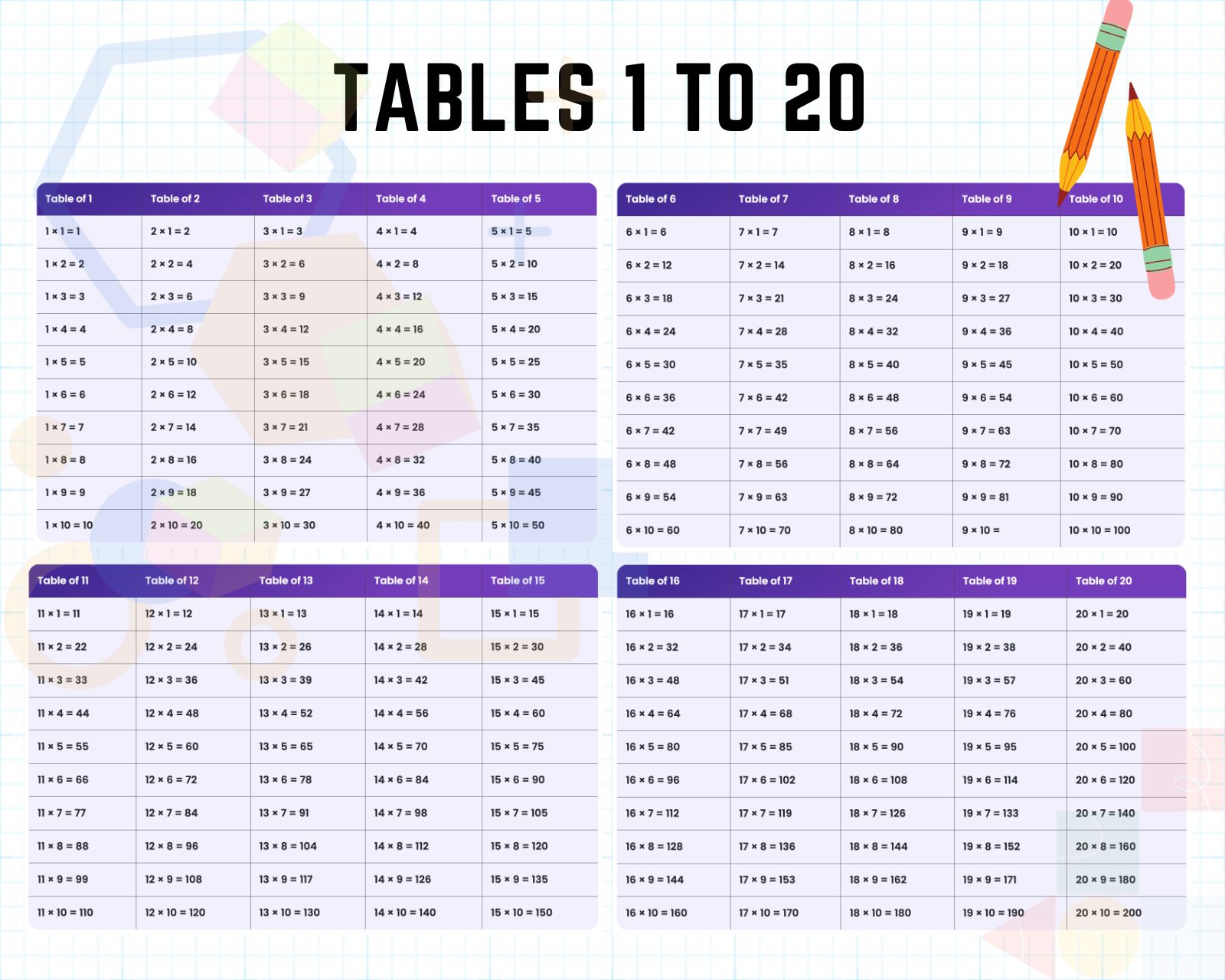Tables 1 to 20 | Download tables 1 to 20 pdf files
by Yogi P - December 19, 2023
Guide to Multiplication Tables 1 to 20
Tables 1 to 20, encompassing multiplication tables, are an essential tool in mathematics. These tables display the multiples of whole numbers ranging from 1 to 20. Mastery of maths tables from 1 to 20 greatly aids students in swiftly solving multiplication problems.
Notably, the table of 1, which results in the same value as the multiplier, can often be bypassed in favor of focusing on the more complex tables 2 to 20. A practical approach for students is to initially concentrate on learning the maths tables from 1 to 10 and, once comfortable, advance to tackling the higher-numbered tables.
To facilitate learning, various tips and tricks have been compiled to assist students in efficiently memorizing these tables, thereby enhancing their arithmetic skills.
Multiplication Tables: The Building Blocks of Arithmetic
Mastering multiplication tables from 1 to 20 is a foundational journey that significantly enhances our mathematical abilities. These tables represent more than mere memorization—they are keys to faster calculations and a deeper understanding of various mathematical concepts.
The Significance of Tables 1 to 20
The tables 1 to 20 form the bedrock of arithmetic. Starting with the simple Table of 1, which establishes the basics, and progressing to the more complex Table of 20, each table serves a specific purpose in developing numerical fluency and skills.
The Essential Role of Multiplication Tables
From the Table of 1, which introduces the concept of multiplication, to the Table of 20, these tables are the cornerstones of arithmetic learning. They are not just lists of numbers, but tools that open the door to advanced mathematics, from basic arithmetic operations to complex problem-solving in algebra and beyond.
Tables 1 to 20: The Foundation of Mathematical Calculations
The mastery of these multiplication tables lays the groundwork for solid mathematical understanding. Considered as fundamental as learning the alphabet, the tables 1 to 20 are vital for students to memorize for quicker mental calculations and understanding patterns in mathematics.
Table Format for Multiplication Tables
The multiplication tables from 1 to 20 can be structured as follows:
- Tables 1 to 5: Simple and introductory, ideal for young learners starting their mathematical journey.
- Tables 6 to 10: These build upon the earlier tables, introducing larger numbers and more complex multiplications.
- Tables 11 to 15 and 16 to 20: These tables are more advanced and are essential for older students, covering a comprehensive range of multiplications.
Incorporating Tables into Learning
Including the actual tables in study materials is highly effective. Here’s an example layout for tables from 1 to 20:
Tables 1 to 5
- Simple multiplication facts, easy to memorize and understand.
| Table of 1 | Table of 2 | Table of 3 | Table of 4 | Table of 5 |
|---|---|---|---|---|
| 1 × 1 = 1 | 2 × 1 = 2 | 3 × 1 = 3 | 4 × 1 = 4 | 5 × 1 = 5 |
| 1 × 2 = 2 | 2 × 2 = 4 | 3 × 2 = 6 | 4 × 2 = 8 | 5 × 2 = 10 |
| 1 × 3 = 3 | 2 × 3 = 6 | 3 × 3 = 9 | 4 × 3 = 12 | 5 × 3 = 15 |
| 1 × 4 = 4 | 2 × 4 = 8 | 3 × 4 = 12 | 4 × 4 = 16 | 5 × 4 = 20 |
| 1 × 5 = 5 | 2 × 5 = 10 | 3 × 5 = 15 | 4 × 5 = 20 | 5 × 5 = 25 |
| 1 × 6 = 6 | 2 × 6 = 12 | 3 × 6 = 18 | 4 × 6 = 24 | 5 × 6 = 30 |
| 1 × 7 = 7 | 2 × 7 = 14 | 3 × 7 = 21 | 4 × 7 = 28 | 5 × 7 = 35 |
| 1 × 8 = 8 | 2 × 8 = 16 | 3 × 8 = 24 | 4 × 8 = 32 | 5 × 8 = 40 |
| 1 × 9 = 9 | 2 × 9 = 18 | 3 × 9 = 27 | 4 × 9 = 36 | 5 × 9 = 45 |
| 1 × 10 = 10 | 2 × 10 = 20 | 3 × 10 = 30 | 4 × 10 = 40 | 5 × 10 = 50 |
Tables 6 to 10
- Expanding the learner’s understanding with more significant numbers.
| Table of 6 | Table of 7 | Table of 8 | Table of 9 | Table of 10 |
|---|---|---|---|---|
| 6 × 1 = 6 | 7 × 1 = 7 | 8 × 1 = 8 | 9 × 1 = 9 | 10 × 1 = 10 |
| 6 × 2 = 12 | 7 × 2 = 14 | 8 × 2 = 16 | 9 × 2 = 18 | 10 × 2 = 20 |
| 6 × 3 = 18 | 7 × 3 = 21 | 8 × 3 = 24 | 9 × 3 = 27 | 10 × 3 = 30 |
| 6 × 4 = 24 | 7 × 4 = 28 | 8 × 4 = 32 | 9 × 4 = 36 | 10 × 4 = 40 |
| 6 × 5 = 30 | 7 × 5 = 35 | 8 × 5 = 40 | 9 × 5 = 45 | 10 × 5 = 50 |
| 6 × 6 = 36 | 7 × 6 = 42 | 8 × 6 = 48 | 9 × 6 = 54 | 10 × 6 = 60 |
| 6 × 7 = 42 | 7 × 7 = 49 | 8 × 7 = 56 | 9 × 7 = 63 | 10 × 7 = 70 |
| 6 × 8 = 48 | 7 × 8 = 56 | 8 × 8 = 64 | 9 × 8 = 72 | 10 × 8 = 80 |
| 6 × 9 = 54 | 7 × 9 = 63 | 8 × 9 = 72 | 9 × 9 = 81 | 10 × 9 = 90 |
| 6 × 10 = 60 | 7 × 10 = 70 | 8 × 10 = 80 | 9 × 10 = | 10 × 10 = 100 |
Tables 11 to 15
- Providing a broader range of multiplication facts for advanced arithmetic.
| Table of 11 | Table of 12 | Table of 13 | Table of 14 | Table of 15 |
|---|---|---|---|---|
| 11 × 1 = 11 | 12 × 1 = 12 | 13 × 1 = 13 | 14 × 1 = 14 | 15 × 1 = 15 |
| 11 × 2 = 22 | 12 × 2 = 24 | 13 × 2 = 26 | 14 × 2 = 28 | 15 × 2 = 30 |
| 11 × 3 = 33 | 12 × 3 = 36 | 13 × 3 = 39 | 14 × 3 = 42 | 15 × 3 = 45 |
| 11 × 4 = 44 | 12 × 4 = 48 | 13 × 4 = 52 | 14 × 4 = 56 | 15 × 4 = 60 |
| 11 × 5 = 55 | 12 × 5 = 60 | 13 × 5 = 65 | 14 × 5 = 70 | 15 × 5 = 75 |
| 11 × 6 = 66 | 12 × 6 = 72 | 13 × 6 = 78 | 14 × 6 = 84 | 15 × 6 = 90 |
| 11 × 7 = 77 | 12 × 7 = 84 | 13 × 7 = 91 | 14 × 7 = 98 | 15 × 7 = 105 |
| 11 × 8 = 88 | 12 × 8 = 96 | 13 × 8 = 104 | 14 × 8 = 112 | 15 × 8 = 120 |
| 11 × 9 = 99 | 12 × 9 = 108 | 13 × 9 = 117 | 14 × 9 = 126 | 15 × 9 = 135 |
| 11 × 10 = 110 | 12 × 10 = 120 | 13 × 10 = 130 | 14 × 10 = 140 | 15 × 10 = 150 |
Tables 16 to 20
- Providing a broader range of multiplication facts for advanced and complex arithmetic.
| Table of 16 | Table of 17 | Table of 18 | Table of 19 | Table of 20 |
|---|---|---|---|---|
| 16 × 1 = 16 | 17 × 1 = 17 | 18 × 1 = 18 | 19 × 1 = 19 | 20 × 1 = 20 |
| 16 × 2 = 32 | 17 × 2 = 34 | 18 × 2 = 36 | 19 × 2 = 38 | 20 × 2 = 40 |
| 16 × 3 = 48 | 17 × 3 = 51 | 18 × 3 = 54 | 19 × 3 = 57 | 20 × 3 = 60 |
| 16 × 4 = 64 | 17 × 4 = 68 | 18 × 4 = 72 | 19 × 4 = 76 | 20 × 4 = 80 |
| 16 × 5 = 80 | 17 × 5 = 85 | 18 × 5 = 90 | 19 × 5 = 95 | 20 × 5 = 100 |
| 16 × 6 = 96 | 17 × 6 = 102 | 18 × 6 = 108 | 19 × 6 = 114 | 20 × 6 = 120 |
| 16 × 7 = 112 | 17 × 7 = 119 | 18 × 7 = 126 | 19 × 7 = 133 | 20 × 7 = 140 |
| 16 × 8 = 128 | 17 × 8 = 136 | 18 × 8 = 144 | 19 × 8 = 152 | 20 × 8 = 160 |
| 16 × 9 = 144 | 17 × 9 = 153 | 18 × 9 = 162 | 19 × 9 = 171 | 20 × 9 = 180 |
| 16 × 10 = 160 | 17 × 10 = 170 | 18 × 10 = 180 | 19 × 10 = 190 | 20 × 10 = 200 |
Practical Applications and Exercises
Include practical examples and exercises using Tables 1 to 20 for real-world applications, enhancing understanding and retention.
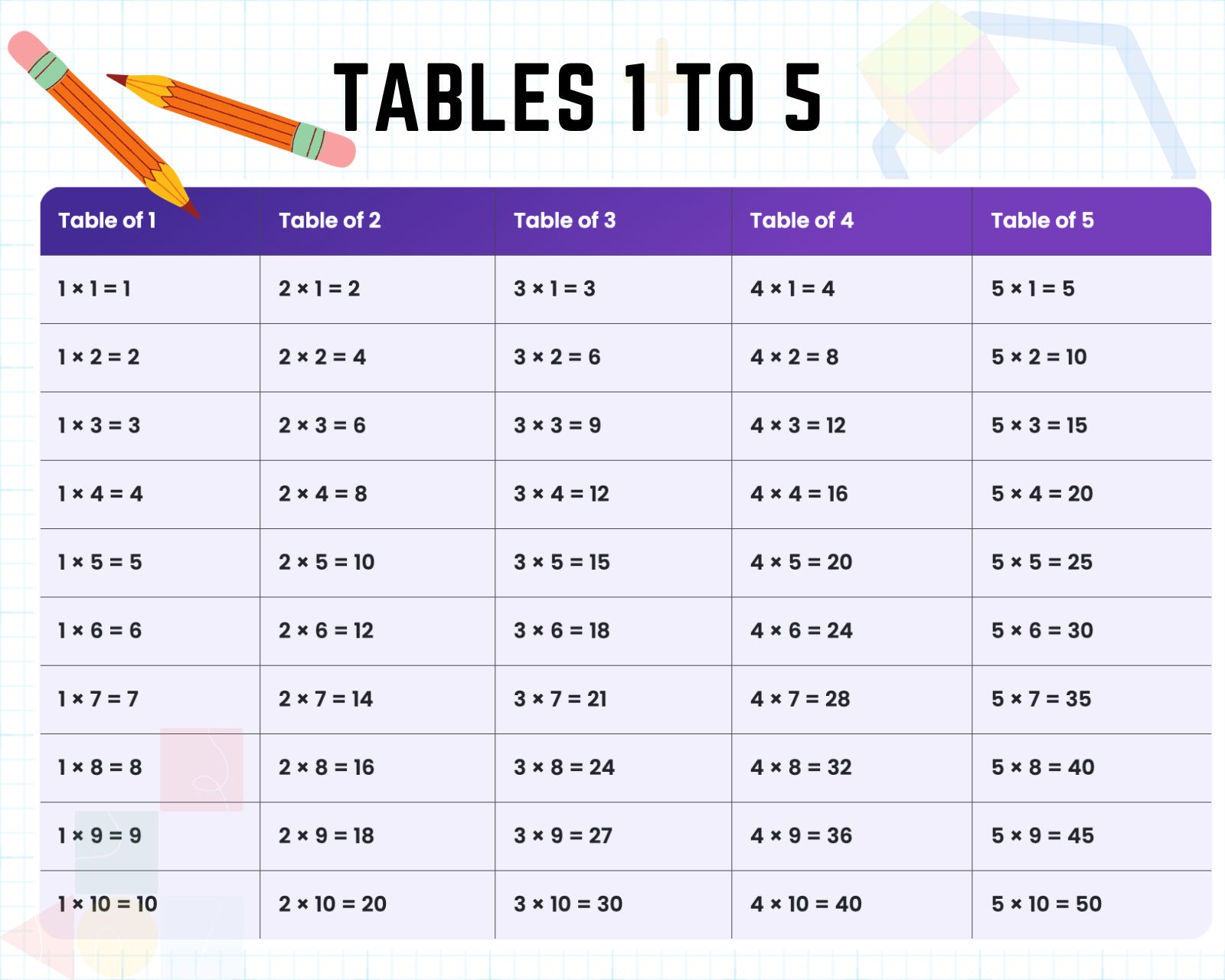
|
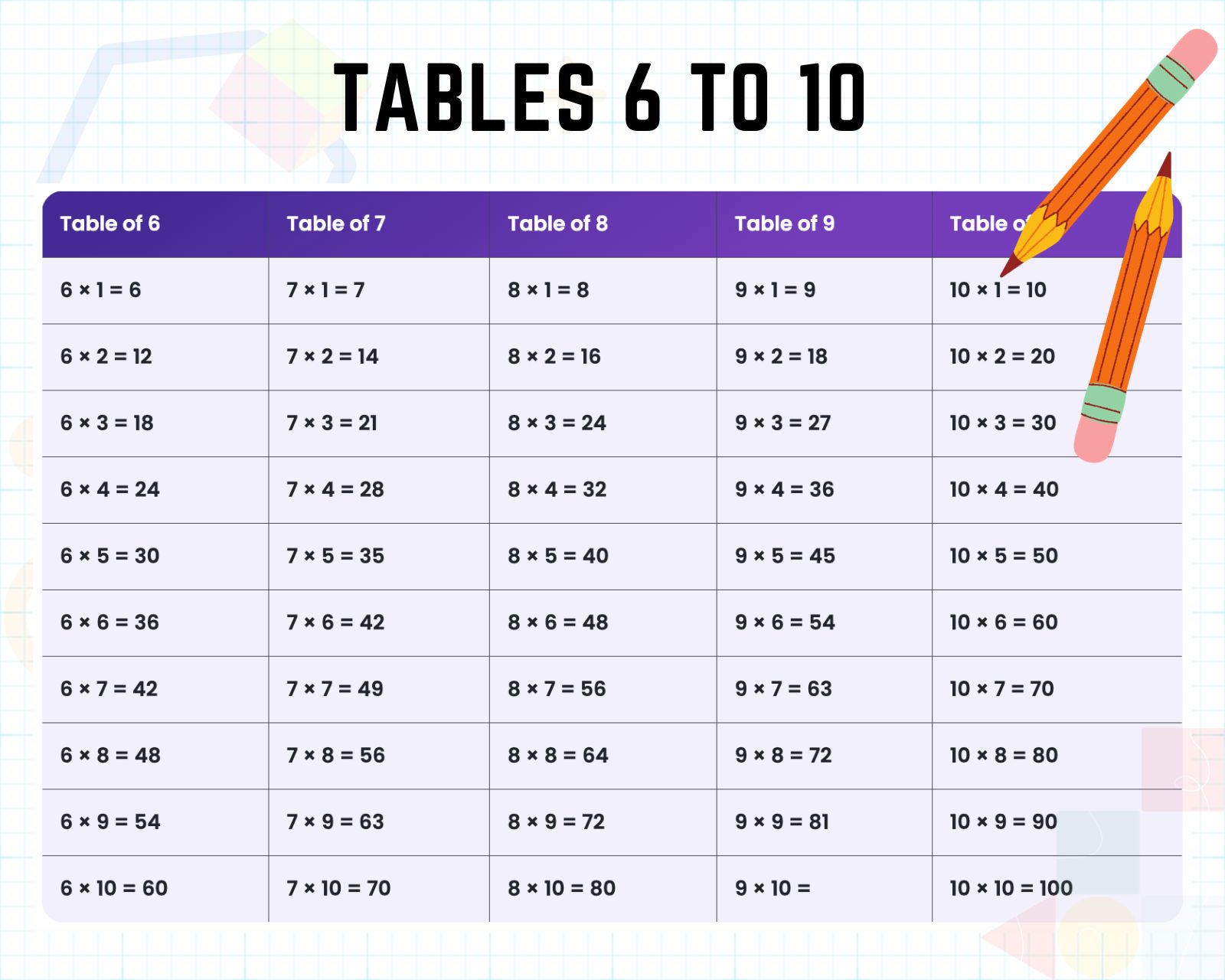
|
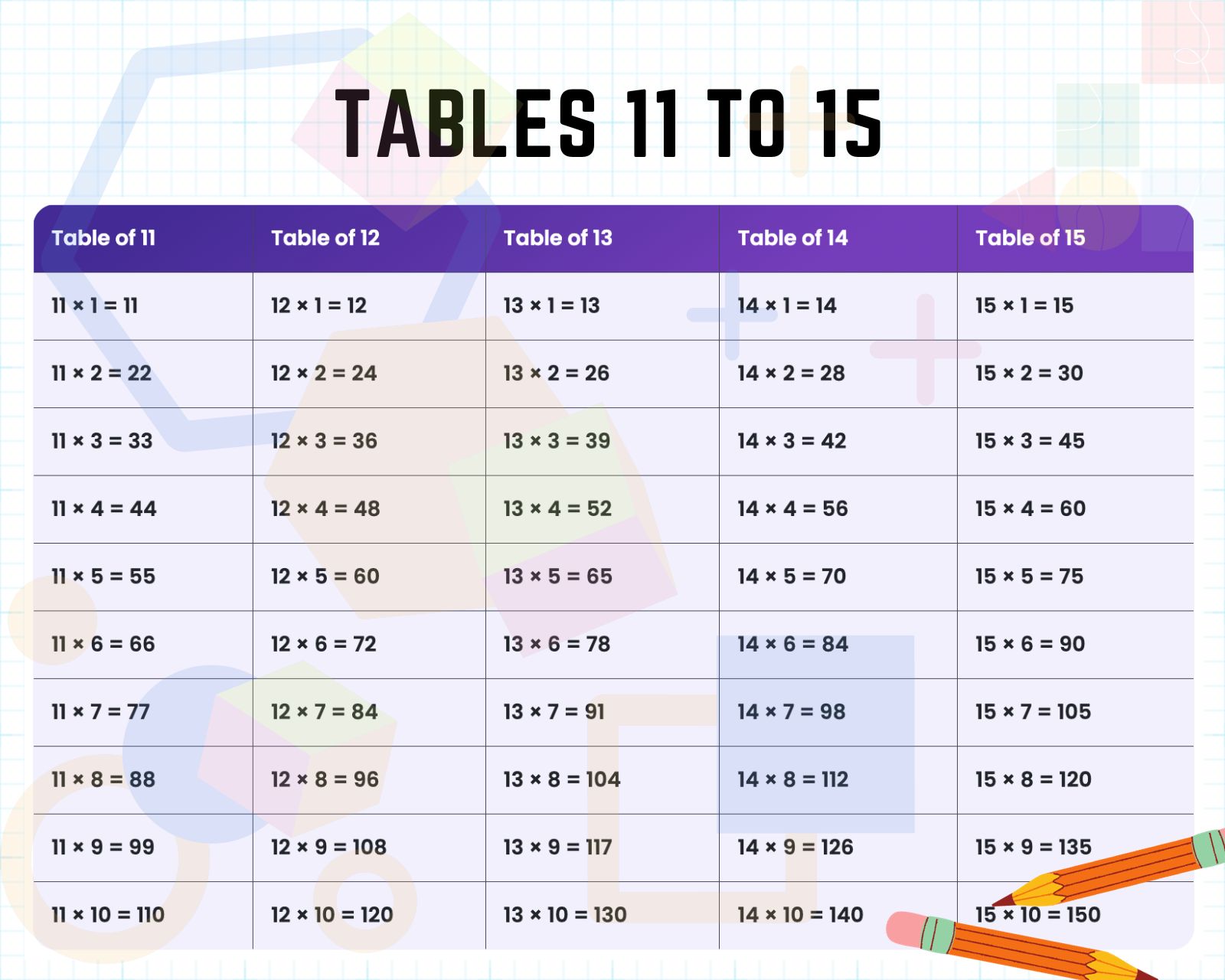
|
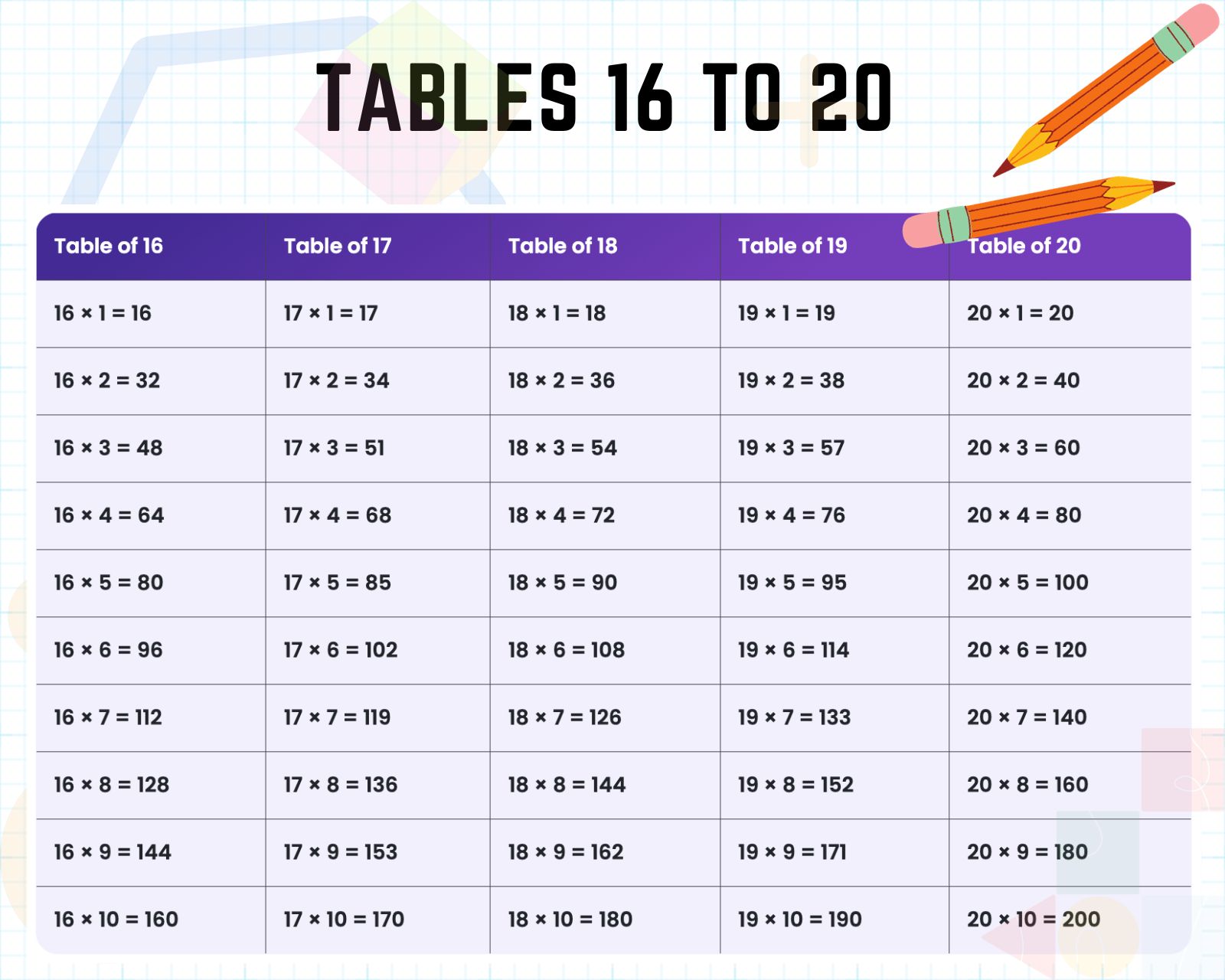
|
Embracing the Power of Tables in Learning
Multiplication tables from 1 to 20 are invaluable for building arithmetic literacy. By presenting these tables in a clear, systematic format, learners can easily memorize and utilize them, paving the way for success in mathematics and everyday life.
Here is a quick reference for multiplication facts from 1 to 10, making it a useful tool for students learning basic arithmetic. Multiplication table chart from 1 to 10 presented in a tabular format:
| × (Times) | 1 | 2 | 3 | 4 | 5 | 6 | 7 | 8 | 9 | 10 |
|---|---|---|---|---|---|---|---|---|---|---|
| 1 | 1 | 2 | 3 | 4 | 5 | 6 | 7 | 8 | 9 | 10 |
| 2 | 2 | 4 | 6 | 8 | 10 | 12 | 14 | 16 | 18 | 20 |
| 3 | 3 | 6 | 9 | 12 | 15 | 18 | 21 | 24 | 27 | 30 |
| 4 | 4 | 8 | 12 | 16 | 20 | 24 | 28 | 32 | 36 | 40 |
| 5 | 5 | 10 | 15 | 20 | 25 | 30 | 35 | 40 | 45 | 50 |
| 6 | 6 | 12 | 18 | 24 | 30 | 36 | 42 | 48 | 54 | 60 |
| 7 | 7 | 14 | 21 | 28 | 35 | 42 | 49 | 56 | 63 | 70 |
| 8 | 8 | 16 | 24 | 32 | 40 | 48 | 56 | 64 | 72 | 80 |
| 9 | 9 | 18 | 27 | 36 | 45 | 54 | 63 | 72 | 81 | 90 |
| 10 | 10 | 20 | 30 | 40 | 50 | 60 | 70 | 80 | 90 | 100 |
Frequently Asked Questions on Tables 1 to 20
Q1. Why are multiplication tables from 1 to 20 important?
Multiplication tables 1 to 20 are fundamental in mathematics. They form the basis for understanding more complex mathematical concepts, aid in quick calculations, and are essential for problem-solving in various areas of mathematics and daily life.
Q2. At what age should children start learning tables 1 to 20?
Children can begin learning the simpler tables (like 1 to 5) as early as kindergarten or first grade (around ages 5-6). As they grow older and their understanding of numbers develops, they can gradually learn higher tables up to 20.
Q3. Are there any tricks to easily memorize tables 1 to 20?
Yes, there are several mnemonic techniques and patterns in the tables that can help in memorization. For example, the table of 10 always ends in zero, and the table of 5 ends in either 0 or 5. Discovering such patterns can make learning tables easier and more fun.
Q4. How often should students practice multiplication tables?
Regular practice is key. Daily short practice sessions are more effective than infrequent, longer sessions. Repetition helps in committing the tables to long-term memory.
Q5. Is understanding multiplication tables still relevant in the age of calculators and computers?
Absolutely. While technology is a helpful tool, having a strong mental grasp of multiplication tables enhances mental arithmetic skills, improves number sense, and is crucial for those times when technology is not accessible.
Q6. Can learning tables 1 to 20 help with learning other subjects?
Yes, mastery of multiplication tables aids in other subjects like science, where calculations are often needed, and even in subjects like music and art, where understanding patterns and rhythms can be enhanced by a good grasp of numbers.
Q7. Are there any resources or tools that can help with learning tables 1 to 20?
There are many resources available, including educational apps, online games, flashcards, and worksheets. Interactive tools can be particularly effective in keeping children engaged while learning.
Q8. What is the best method to teach tables 1 to 20 to children?
Each child is different, so it’s best to use a combination of methods including rote memorization, interactive games, practical application, and discovering patterns within the tables. This multifaceted approach caters to different learning styles.
